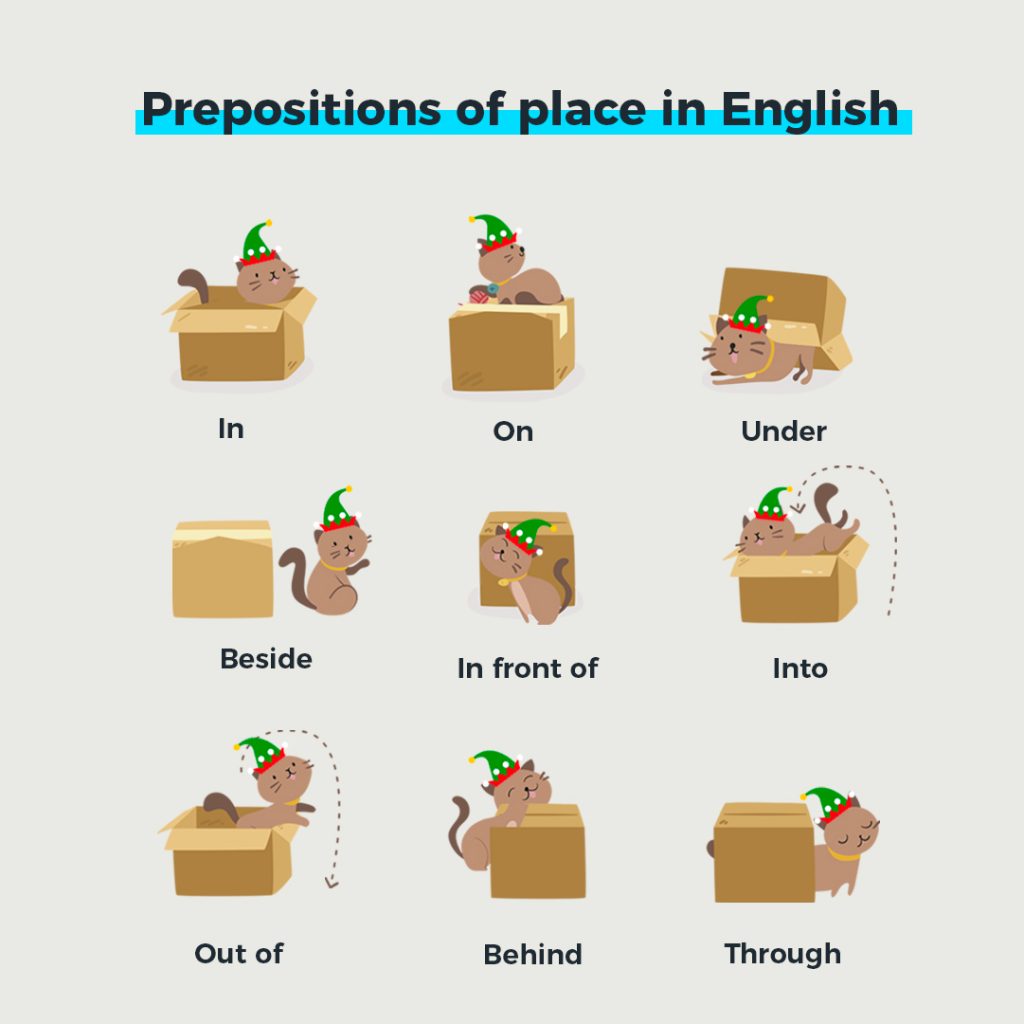At first glance, this might seem very simple. Then, in just a moment, you realize that you don’t know which to choose. Is it at or in?
Don’t worry! With a little study and some practice, you’ll finally be able to use them without problems.
Come and discover all the features of the prepositions of place in English! Learn how to identify them according to type, how to distinguish between “location in a place” and “movement to/from a place,” and much more. We hope you learn a lot!
What are the prepositions of place in English and how are they used?
A preposition of place is the part of speech that provides information about the location of an action or event.
To create the prepositional phrase, a preposition of place needs to come before the complement. To use them optimally, there are two types of sentence structure:
- Preposition (and complement) + subject + verb
On the bed + Jennifer + is sleeping.
- Subject + verb + preposition (and complement)… etc.
Jennifer + is sleeping + on the bed.
What are the most common prepositions of place?
At and in are the two most common prepositions of place. Let’s see what makes them special.
At is used:
- For exact addresses
My school is at 25 Oxford Street.
- When you refer to a place only by its function, but not physically
We will meet at the cinema.
- When you talk about a place, referring to an event taking place rather than the physical space
I was at the sea.
I will be at work.
In is used:
- For streets without an address
My school is in Oxford Street.
- For countries, cities, and all geographical names
Emmanuelle lives in France.
- When you refer to a place physically
I have a meeting in that office.
Can you find the preposition of place in this sentence? “Yesterday, we met at the restaurant.”
Exactly! The preposition of place was at. If you couldn’t find it, don’t worry. You can test your English level to find the right content for you to be able to reach the level you want.
Prepositions of state
Obviously, there are as many prepositions to express the state in a place as there are possibilities to be in a space!
| On indicates being on top of something. | The cat is on the table. |
| Over indicates being above something else, without touching. | The airplane is over our heads. |
| Above indicates the same as over, but in a more generic way. | The city is above the valley. |
| Under means below. | The cat is under the table. |
| Among indicates being a part of many. | You are the best among us. |
| Between indicates being in the middle of two. | Mark is between Laura and Jack. |
| Behind indicates in the back of. | Mark is behind the tree. |
| In front of and opposite indicate facing someone or something. | The school is in front of the cinema. |
| Near indicates being close in a generic way. | The school is near the cinema. |
| Around expresses being close to. | The children sit around the teacher. |
| Next to indicates to be beside or directly adjacent. | The school is next to the cinema. |
Prepositions of movement
There are fewer prepositions related to movement to/from a place, so it’ll be easier for you to remember them.
- From indicates an action that began in a certain place
I come from Colombia.
I’m coming from school.
- To indicates that an action is going towards a place
I go to school.
- Into is very similar to to, but only refers to enclosed spaces
I’m going into the school.
- Through indicates crossing an enclosed space
I walk through the tunnel.
- Across indicates crossing an open space
I walk across the street.
A bit of advice for you to study
Pay attention! Many prepositions of place might have the same meaning when translated into your mother tongue, but they aren’t equivalent in English.
Keep this in mind so that you don’t always use the same prepositions. With a little extra effort, your English will be perfect!
Prepositions of place practice exercises
Complete the sentences with the correct preposition!
- Alejandra is Spanish. She is ______________ Madrid.
- Water flows _______________ the pipes.
- I live _________ 37 Park Avenue.
- What’s your favorite movie _________ these ones?
- I’m not sure. There was a bar _______ the school.
Some of these sentences are badly written. Can you tell which ones are incorrect?
- I’m sitting over my sofa.
- I will travel into Spain.
- I have a lesson at school.
- I have a lesson in that room.
After reading this content, you’ll definitely have learned what prepositions of place are and how to use them. Not only that, now you’ll never confuse at and in. You’ll have finally learned exactly what the prepositions of state and movement mean.
But this is only the beginning. Start the course now and practice what you’ve just discovered. Move fast! You’ll surprise everyone with your use of prepositions!
Remember that there are still many topics for us to explore together. If you liked this post, share it. We’ll see you again on the blog to learn more soon!

 ABA Journal The digital English academy
ABA Journal The digital English academy





